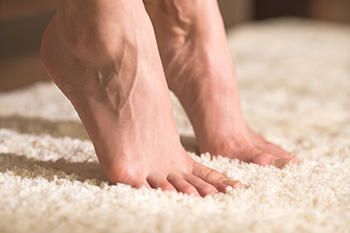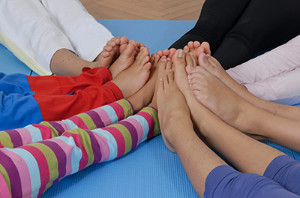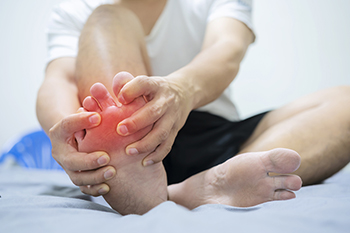Connect With Us
Blog
Items filtered by date: October 2022
Effective Foot Stretches and How to Perform Them

There are many benefits to frequently performing foot exercises. Stretching and exercising the feet make them stronger, and this can be helpful in possibly preventing falls, in addition to reducing existing foot and ankle pain. The range of motion is often improved, and slow stretching can improve flexibility. When the toes are raised, pointed, and curled, it may help to strengthen the Achilles tendon, which is connected to the heel. This can be done by sitting in a chair, and alternating pointing, raising, and curling the toes. Each position can be held for a few seconds, then repeated approximately 10 times. An effective stretch for the toes is called the toe splay and is also done while sitting in a chair. The heels can be firmly resting on the ground, and the toes are stretched out and moved several times. The entire foot can be strengthened when toe extensions are performed. While one leg is crossed over the other, take one hand and manually move the toes back until a gentle stretch is felt. If you would like more information about the benefits of exercising the feet, please speak with a podiatrist who can recommend specific stretches for you.
Exercising your feet regularly with the proper foot wear is a great way to prevent injuries and build strength. If you have any concerns about your feet, contact Ronald Pieroni, DPM from Bolingbrook Foot and Ankle Center. Our doctor can provide the care you need to keep you pain-free and on your feet.
Exercise for Your Feet
Exercise for your feet can help you gain strength, mobility and flexibility in your feet. They say that strengthening your feet can be just as rewarding as strengthening another part of the body. Your feet are very important, and we often forget about them in our daily tasks. But it is because of our feet that are we able to get going and do what we need to. For those of us fortunate enough to not have any foot problems, it is an important gesture to take care of them to ensure good health in the long run.
Some foot health exercises can include ankle pumps, tip-toeing, toe rises, lifting off the floor doing reps and sets, and flexing the toes. It is best to speak with Our doctor to determine an appropriate regimen for your needs. Everyone’s needs and bodies are different, and the activities required to maintain strength in the feet vary from individual to individual.
Once you get into a routine of doing regular exercise, you may notice a difference in your feet and how strong they may become.
If you have any questions please feel free to contact our office located in Bolingbrook, IL . We offer the newest diagnostic and treatment technologies for all your foot and ankle needs.
Plantar Warts Can Be Treated!
What Is Sweaty Sock Syndrome?

Helping your child maintain healthy feet is a critical step in enabling the child to grow into a strong and vibrant adult. One foot condition that can potentially compromise this goal is known as sweaty sock syndrome. This foot condition primarily affects children, particularly boys between the ages of 4 and 8. Sweaty sock syndrome can make an individual exhibit a red, scaly rash on the bottoms, or soles, of the feet. Specifically, the heel and big toe are areas of the sole that can be affected. Interestingly, some children with this condition may say that they feel as though their feet are sweating. However, the rash tends to feel dry. In some cases, the affected area may develop cracks, or fissures, in the skin. If you believe that your child may have this condition, it is best to contact a podiatrist to examine your child’s feet, particularly if they have fissures. Schedule an appointment with a podiatrist today.
Making sure that your children maintain good foot health is very important as they grow. If you have any questions, contact Ronald Pieroni, DPM of Bolingbrook Foot and Ankle Center. Our doctor can provide the care you need to keep you pain-free and on your feet.
Keeping Children's Feet Healthy
Having healthy feet during childhood can help prevent medical problems later in life, namely in the back and legs. As children grow, their feet require different types of care. Here are some things to consider...
Although babies do not walk yet, it is still very important to take care of their feet.
Avoid putting tight shoes or socks on his or her feet.
Allow the baby to stretch and kick his or her feet to feel comfortable.
As a toddler, kids are now on the move and begin to develop differently. At this age, toddlers are getting a feel for walking, so don’t be alarmed if your toddler is unsteady or ‘walks funny’.
As your child gets older, it is important to teach them how to take care of their feet.
Show them proper hygiene to prevent infections such as fungus.
Be watchful for any pain or injury.
Have all injuries checked by a doctor as soon as possible.
Comfortable, protective shoes should always be worn, especially at play.
If you have any questions please feel free to contact our office located in Bolingbrook, IL . We offer the newest diagnostic and treatment technologies for all your foot and ankle needs.
Excess Uric Acid, Crystals, and Gout

When uric acid amounts in the blood rise to an elevated level, it may produce a foot condition that is known as gout. It can develop into crystals that lodge in the joints of the big toe, and can cause debilitating pain. Gout is considered to be a form of arthritis, and swelling, heat, and redness can be symptoms that can accompany this foot condition. It can be caused by genetics or from eating foods that have large amounts of purines. These can include shellfish, red meat, and drinks that are made with excessive amounts of sugar. Most gout patients are under the care of a podiatrist who can extract a sample of the crystals that lie in the joints to obtain a proper diagnosis. Some patients need to have an X-ray or a CT scan performed to confirm the findings. Effective methods that may help to prevent gout can include consuming a healthy diet daily, drinking plenty of water, and engaging in an exercise routine. Gout attacks can happen frequently, and it is strongly advised that a podiatrist be contacted as quickly as possible who can help you to manage this uncomfortable foot condition.
Gout is a painful condition that can be treated. If you are seeking treatment, contact Ronald Pieroni, DPM from Bolingbrook Foot and Ankle Center. Our doctor will treat your foot and ankle needs.
What Is Gout?
Gout is a form of arthritis that is characterized by sudden, severe attacks of pain, redness, and tenderness in the joints. The condition usually affects the joint at the base of the big toe. A gout attack can occur at any random time, such as the middle of the night while you are asleep.
Symptoms
- Intense Joint Pain - Usually around the large joint of your big toe, and it most severe within the first four to twelve hours
- Lingering Discomfort - Joint discomfort may last from a few days to a few weeks
- Inflammation and Redness -Affected joints may become swollen, tender, warm and red
- Limited Range of Motion - May experience a decrease in joint mobility
Risk Factors
- Genetics - If family members have gout, you’re more likely to have it
- Medications - Diuretic medications can raise uric acid levels
- Gender/Age - Gout is more common in men until the age of 60. It is believed that estrogen protects women until that point
- Diet - Eating red meat and shellfish increases your risk
- Alcohol - Having more than two alcoholic drinks per day increases your risk
- Obesity - Obese people are at a higher risk for gout
Prior to visiting your podiatrist to receive treatment for gout, there are a few things you should do beforehand. If you have gout you should write down your symptoms--including when they started and how often you experience them, important medical information you may have, and any questions you may have. Writing down these three things will help your podiatrist in assessing your specific situation so that he or she may provide the best route of treatment for you.
If you have any questions, please feel free to contact our office located in Bolingbrook, IL . We offer the newest diagnostic and treatment technologies for all your foot care needs.
Burn Blisters

Many people will develop a blister at one point in their lives due to repeated friction. For example, when wearing an ill-fitting pair of shoes, the material of the shoes might rub against the skin in an uncomfortable way, sometimes creating a blister. Burn blisters, however, develop not in response to friction but in order to protect an area of the skin that has been burned. For instance, a burn blister may develop on the foot after it has suffered a sunburn or second-degree burn of some kind. If you have a burn blister on your foot due to a second degree burn, seek out medical assistance immediately. This is especially true if you notice that there is swelling, redness, or pus around the blister. Of course, it is always important to resist the urge to pop a burn blister, because this increases the likelihood of developing an infection. Contact a podiatrist today for more information about burn blisters.
Blisters are prone to making everyday activities extremely uncomfortable. If your feet are hurting, contact Ronald Pieroni, DPM of Bolingbrook Foot and Ankle Center. Our doctor can provide the care you need to keep you pain-free and on your feet.
Foot Blisters
Foot blisters develop as a result of constantly wearing tight or ill-fitting footwear. This happens due to the constant rubbing from the shoe, which can often lead to pain.
What Are Foot Blisters?
A foot blister is a small fluid-filled pocket that forms on the upper-most layer of the skin. Blisters are filled with clear fluid and can lead to blood drainage or pus if the area becomes infected.
How Do Blisters Form?
Blisters on the feet are often the result of constant friction of skin and material, usually by shoe rubbing. Walking in sandals, boots, or shoes that don’t fit properly for long periods of time can result in a blister. Having consistent foot moisture and humidity can easily lead to blister formation.
Prevention & Treatment
It is important to properly care for the affected area in order to prevent infection and ease the pain. Do not lance the blister and use a Band-Aid to provide pain relief. Also, be sure to keep your feet dry and wear proper fitting shoes. If you see blood or pus in a blister, seek assistance from a podiatrist.
If you have any questions, please feel free to contact our office located in Bolingbrook, IL . We offer the newest diagnostic and treatment technologies for all your foot care needs.

